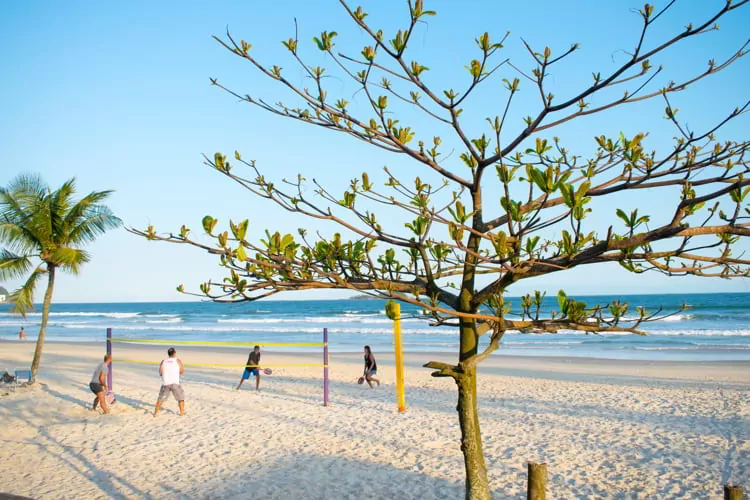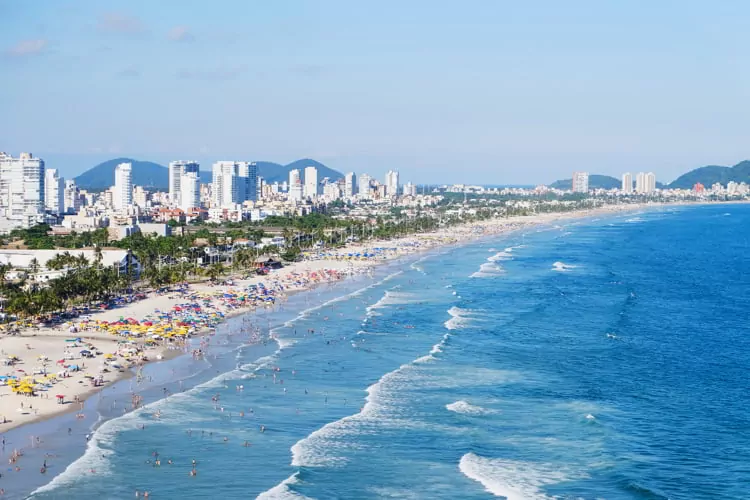A Tale Of Two Cities, Part 2: Guarujá
Just across the estuary from Santos lies Guarujá. Though only four minutes from Santos by balsa (ferry), Guarujá is quite different in many respects.
Whereas Santos bustles, Guarujá is more of a laid-back beach town. In fact, a quick search online of the top things to do in Guarujá will present a list of beaches, more beaches, and still more beaches. Oh, and the Acqua Mundo aquarium, with its sharks and penguins.
Guarujá is full of vacationing paulistanos (residents of São Paulo city) during the summer months (December to February), and again during the July holidays. Throughout the rest of the year, it lies largely dormant.
Which makes it very attractive to me.
More and more as the years pass, I value tranquility, which can be difficult to find in Latin America. But for many months of each year, Guarujá is quite calm, especially during the week. As an example, in my building there are 27 apartments, only 4 of which (including mine) are occupied during the week. I’m currently writing this downstairs on a long picnic table between the tall brick barbecue grill and the swimming pool, and haven’t seen anyone in the last hour. Most buildings in Guarujá are similarly deserted outside of the high season.
I don’t mean to give the impression that Guarujá is a ghost town. Shops aren’t boarded up, and there aren’t tumbleweeds rolling down dusty streets. The locals are going about their lives. There are always folks at the beach except on the rainiest of days—and even then the die-hard surfers are out, hunting for rogue waves.
But things are kind of sleepy now. Admittedly, Guarujá in the off season might be too quiet for some. Personally, I love it. And each weekend, things pick up a bit, as the paulistanos slip into town.
Most of these weekenders, by the way, are educated, interesting folks. They have good jobs in the capital city which allow them to keep second homes here. Many speak a bit of English, and they like to practice with me.
From my own explorations, and in speaking to several locals and an American who comes down frequently for business, the consensus is that the most desirable bairros (city districts) here are Pitangueiras, Tombo, and Astúrias.
Pitangueiras has several neighborhoods. I like the Praia das Pitangueiras area around Rua (Street) Mario Ribeiro, near La Plage Shopping. There are many units available here—and realty agencies, too—with everything within easy walking distance. Others like the nearby neighborhood called Barra Funda, which is also centrally located and is lovely, with many shade trees.
A nice fact about Pitangueiras is that the buses do not run along the beachfront as they do in Santos, but instead two blocks inland on Avenida Leomil. Here you could rent a beachfront unit without contending with the constant traffic noise as on the beach in Santos.

I looked at many acceptable rental units available at surprisingly good prices. Of course, I had the fortune to arrive on the last weekend of July, as vacations were ending—and prices falling.
While you’ll definitely want to explore Pitangueiras, don’t overlook Tombo and Astúrias, especially if you value tranquility as much I do. They lie only a five-minute taxi ride from Pitangueiras. Tombo and Astúrias are newer bairros; most buildings are less than 20 years old. In general I found the apartments in these areas to be nicer than those in Pitangueiras or over in Santos—while still being cheaper, presumably for being a bit off the beaten path.
I leased an apartment in Tombo, which is perfect for me: one-bedroom, recently remodeled and tastefully decorated. It has ceiling fans in the bedroom and living room, an air conditioner in the bedroom, and a portable air-conditioning unit in the living room. It also has a washing machine, and even came kitted out with pots and pans and flatware. I’m only four blocks walking from the beach, less as the crow flies. Rent, condo fees, and property taxes bundled together (here termed a pacote, or package) are a tad under US$500 per month.
I’m extremely happy here. My living room looks out over a large vacant lot filled with enormous spreading shade trees. The birds who make their homes there serenade me daily. Between two other apartment buildings I can see a bit of the ocean. I found a gym nearby which I like very much. The beach is less than a block from the gym, so I can grab a coconut after my interval training. There are three small markets within a few minutes of my apartment. I have an easy, simple, compact life.
And if you enjoy the beach, Tombo is hard to beat. While not as long as some others in the area, Tombo Beach is very upscale and well maintained. It has in fact been awarded the coveted international Blue Flag award, in recognition of its pristine condition. It is much more laid-back than the beaches of Santos, which suits me fine. And the sand here is softer, scrunching beneath the toes.
Astúrias is situated adjacent Tombo, on the Pitangueiras side. It’s a small bairro occupying a little peninsula jutting out into the South Atlantic. To the north lies Astúrias Beach, and to the south, Tombo Beach. Like Tombo, it’s a quiet residential area.
There are drawbacks to Tombo and Astúrias. The markets are small, and their selections limited. Prices for groceries and for most services are high for Brazil – though still cheap by North American standards. (A haircut here costs about US$16 instead of US$9, an hour massage US$30 instead of US$20.) But considering what I pay in rent, and that Tombo Beach is thrown in for free, I’m not complaining.
Guarujá is seen by some as less desirable than Santos. There is less to do, and the public services and hospitals aren’t perceived to be of the same caliber. There are favelas, especially to the north near the bairro of Enseada.
Why Did I Choose Guarujá Over Santos?
First, the favelas aren’t located near Pitangueiras, Tombo, or Astúrias, and so don’t concern me. Guarujá offers tranquility and uncrowded beaches (outside of the high season). While Santos certainly offers more in the way of shopping, and has better infrastructure generally, everything in Santos is literally only minutes away from Guarujá. And rents are considerably cheaper on this side of the river.
Note that the real estate market in Guarujá is very seasonal, more so than in Santos, which has more permanent residents. To find deals, the best times to come are August, October, or late March and June.
Which Is Best, Santos Or Guarujá?
It depends on what is most important to you. Many, perhaps a majority, of folks prefer Santos. For me, the low-season tranquility of Guarujá is wonderful, just what I’ve been searching for. Of course, I may change my tune when the temporada (high season) arrives and the holidaymakers roll into town.
But for now, I am enjoying the peace… and my own private swimming pool.

